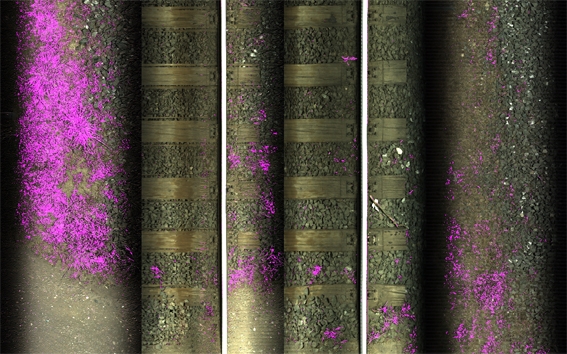Increased efficiency and sustainability in vegetation control
Vegetation in the rail track bed is an issue for rail traffic safety. Weed roots grow into the ballast bed and prevent rainwater from draining away quickly. Silting occurs and the ballast loses its buffer function: Vibrations and shocks caused by passing trains are no longer sufficiently cushioned. Regular control and maintenance of the vegetation in the track bed are therefore indispensable and also required by law. In view of the length of the rail network - in Germany alone there are more than 60,000 track kilometers - vegetation maintenance is a complex and costly process for rail network operators and is usually carried out by specialized service companies.
A multispectral camera system, which Fraunhofer IPM developed for a plant and crop protection service company, now automates the process of green detection. The optical system ensures that pesticides are used as selectively as possible and at the same time enables for the first time a long-term documentation of vegetation growth. The measured data contain GNSS information for exact localization and can be displayed both graphically and in tabular form.
Applying pesticides more precisely
Chemical plant protection products (PPP) are currently still indispensable for the elimination of vegetation along railroad tracks. They ensure the reliable removal of unwanted vegetation and eliminate the so-called seed potential particularly reliably. The optical system for green detection enables the herbicides to be applied automatically and thus more specifically: The camera system, installed at the front of the spraying train, automatically detects green and triggers a sensor signal when a certain threshold value is reached. This activates one or more of the eight movable spray nozzles at the end of the spray train, depending on the degree of coverage determined. Up to now, this process has usually been carried out by two to three specialists who observe the track from the train and trigger the spray command manually.
Camera-based green detection is more selective and reliable than the previous manual method, so that significantly fewer herbicides are used. The optical system for green detection in its first version operates at driving speeds of up to 100 km/h. When used on rails, travel speeds of approx. 50 km/h are common.
The automated green detection is also suitable for optimizing alternative methods of vegetation maintenance. These include, for example, the use of UV light, hot water or electric herbicides, which are currently being developed as an alternative to PPPs.
Multispectral camera system
The camera-based system for green detection uses the characteristic spectral fingerprint of green vegetation, the so-called green gap.

